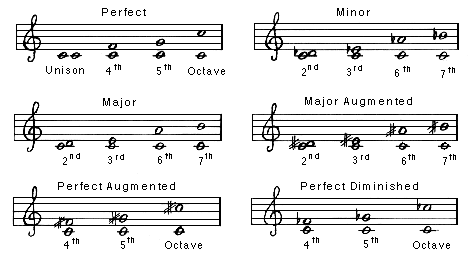The space or distance in PITCH or FREQUENCY between two TONEs or NOTEs. An interval may be defined by its position in a given SCALE, or by the frequency ratio between the two tones (as in scales of JUST INTONATION or the PYTHAGOREAN SCALE), or by the frequency difference measured in cents (as in an equal tempered system).
See also: MEL, QUARTER TONE, TEMPERAMENT, TEMPERED TUNING, Appendix C. Compare: PERFECT PITCH.
In the western 12 tone scale of EQUAL TEMPERAMENT, intervals are also sometimes referred to by the number of semitones comprising the interval. The most commonly named intervals are those of the UNISON, semitone, SECOND, THIRD, FOURTH, FIFTH, SIXTH, SEVENTH and OCTAVE, which have the following representations:
|
Interval Name |
Just |
Intonation |
|
|
|
|
|
|
||
|
Unison |
|
|
|
|
|
Semitone (minor second) |
|
|
|
|
|
Second (major) |
|
|
|
|
|
Third (minor) |
|
|
|
|
|
Third (major) |
|
|
|
|
|
Fourth |
|
|
|
|
|
Fifth |
|
|
|
|
|
Sixth (minor) |
|
|
|
|
|
Sixth (major) |
|
|
|
|
|
Seventh (minor) |
|
|
|
|
|
Seventh (major) |
|
|
|
|
|
Octave |
|
|
|
|
The second, third, sixth and seventh have major and minor forms; the unison, fourth, fifth and octave are called perfect; perfect or major intervals may be augmented (i.e. raised by a semitone); perfect and minor intervals may be diminished (i.e. lowered by a semitone). In 12 tone equal temperament, the augmented fourth and diminished fifth form the interval called the tritone which is comprised of 6 semitones (i.e. a half octave).The following chart shows these intervals in musical notation.

Sound Example: Scale of equal temperament, heard melodically.
Sound Example: Scale of equal temperament, heard as intervals (major & perfect intervals only).Sound Example: Scale of just intonation, heard melodically.
Sound Example: Scale of just intonation, heard as intervals (major & perfect intervals only).
home